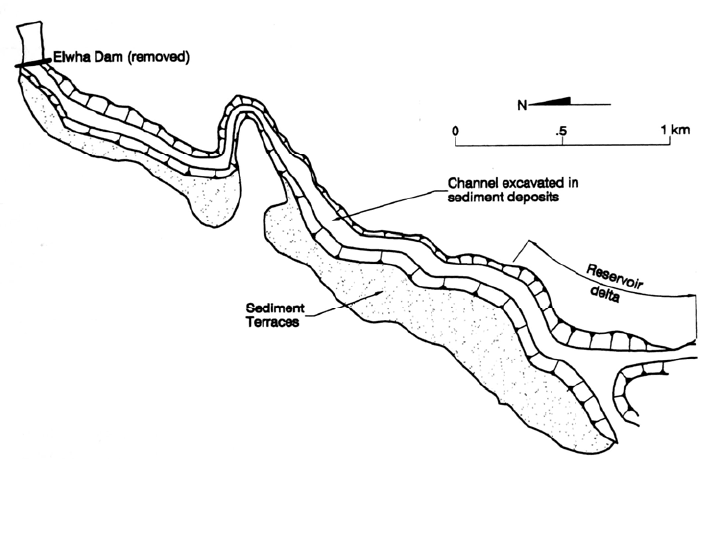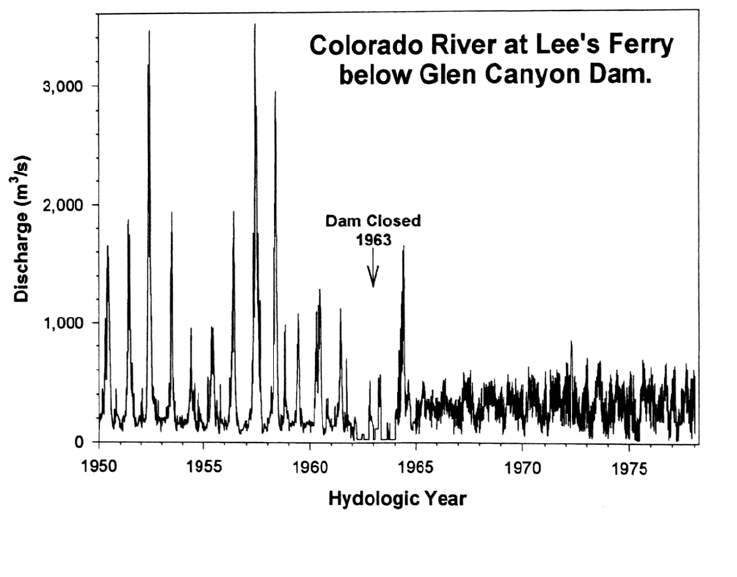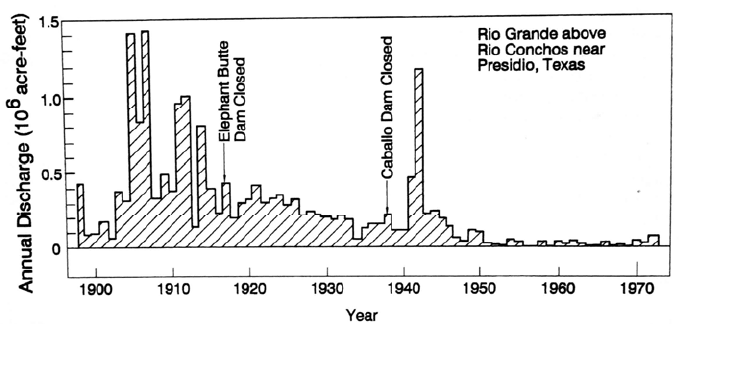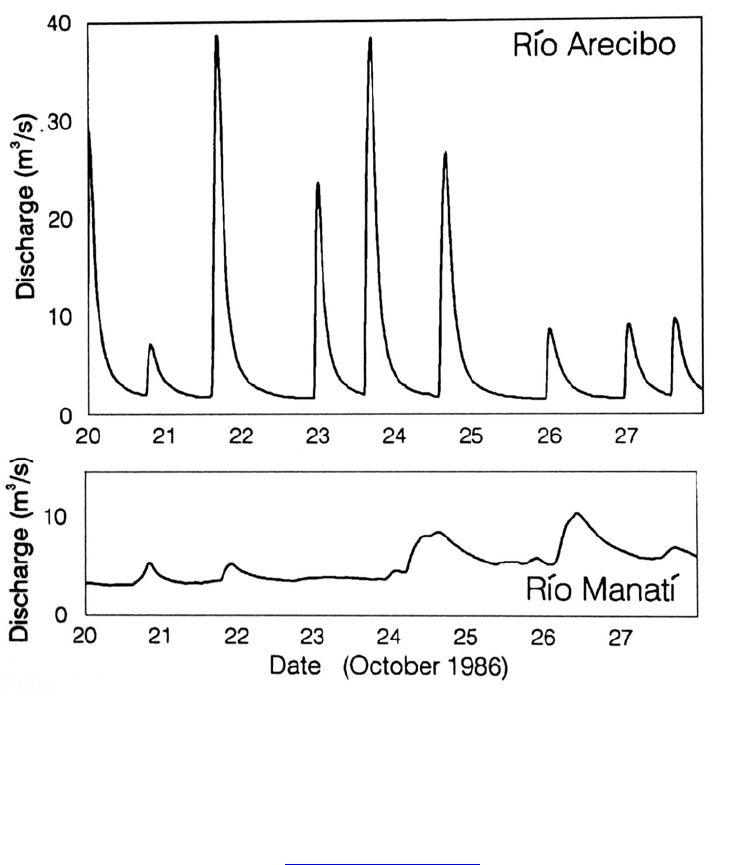Morris & Fan. Reservoir Sedimentation Handbook
Подождите немного. Документ загружается.


DECOMMISSIONING OF DAMS 17.24
scour channel would be allowed to remain in place. After drawdown, it would be
protected by erosion control blankets and revegetated.
FIGURE 17.11 Alignment of proposed channel to be excavated through sediment
deposits above Elwha Dam, if the dam is removed. Sediments excavated from the channel will
be deposited on top of the existing off-channel sediment deposits in the reservoir (after FERC,
1991).
The proposed construction sequence for dam removal takes into account the need to
minimize sediment release. At Elwha Dam a 4.1 m diameter diversion tunnel would be
constructed for dewatering the reservoir below the level of the power intakes, and a
cofferdam would divert the entire river flow into the diversion and away from the
dam area to allow demolition to be performed under dry conditions. Floods
exceeding the diversion capacity would be temporarily stored in the reservoir and,
if large enough, discharged over the dam. A similar procedure would be used at
the Glines Canyon Dam.
A revegetation program would he undertaken in both reservoirs to establish a
cover of native species on the disposal terraces as soon as possible. Terraces would
be carefully graded to reduce erosion, and tributary streams would be carefully
routed across the erodible terraces. Terraces would be seeded and mulched in the
early fall of the year in which they are constructed, and areas affected by winter
erosion would be replanted in the spring. Areas of poor cover would be reseeded in
the fall. The seed mix would consist of sterile forms of fast-growing grass and cover
species as well as native pioneer grasses and forbs. Willow wattling would be
planted in highly erodible areas. Replanting would not be performed during the
dry summer months when there would be little opportunity for plant establishment
on the coarse well-drained sediments.
Excavation and terracing of sediment would be carried out for 2 years in
Lake Aldwell, and for 3 years at Glines Canyon, prior to dam removal. It is expected that
4 to 10 years would be required for the sediment terraces to become stabilized with good
vegetative cover and mulch. Thereafter, sediment levels within the river would be
dominated by natural sediment delivery from the upper watershed rather than

DECOMMISSIONING OF DAMS 17.25
erosion of reservoir deposits. Over a period of centuries the Elwha River channel would
migrate laterally and erode away the terraces through natural processes.
River erosion and additional sediment management alternatives for the Elwha River,
including a slurry pipeline to the coast and mechanical excavation and hauling, have been
described by Randle and Lyons (1995).
17.6 CLOSURE
As dams age, decommissioning and removal is becoming an issue of increasing
importance. Sediment management during and after dam removal is a major technical
and cost component of decommissioning projects. Various strategies for dam removal
and sediment management exist. These methods will become more refined, and
newer approaches will be developed as engineers become more experienced in
dam removal and the concurrent management of sediment.

CHAPTER 18
ENVIRONMENTAL AND REGULATORY
ISSUES
18.1 INTRODUCTION
Dams are the greatest point source of hydrologic disturbance to rivers (Petts, 1984). They
alter the flow of water, sediment, nutrients, energy, and biota and also modify
channel morphology, thereby interrupting and altering most of the river's important
ecological processes. The impact of dams often extends hundreds of kilometers
downstream, and they may also influence estuarine and coastal ecosystems far below
the dam site. Even hydrologically small dams can create large impacts when they
block migration, trap bed material, divert a significant portion of the flow
(especially low flow ), or are sufficiently numerous on a river to significantly reduce
peak discharges. Channel morphology and habitat conditions below a dam are
particularly affected by the reduced magnitude and frequency of flood flows, and the
trapping of coarse bed material in the reservoir. Riparian wetlands and anadromous
fisheries are particularly susceptible to impact.
In concept, the partial or complete restoration of the sediment balance along an
impounded river is environmentally desirable. Ligon et al. (1995) stated that the best
means to preserve the morphology and biota of rivers is to design reservoirs that
pass coarse sediment on a regular basis, consistent with the frequency of natural
sediment transport events. Unfortunately, the coarse bed material is the most difficult
fraction of the inflowing load to pass through the impoundment. Many factors
complicate sediment management, making it difficult, costly, or virtually impossible
to replicate natural patterns of sediment discharge along an impounded river.
Downstream interests may oppose a return to the natural preimpoundment sediment
transport regime. Large flows required to sustain channel morphology may cause
property damage because of human encroachment onto floodplains. New aquatic
species and human uses may have become adapted to the clear cold water in the
reach below the dam, in what was formerly a turbid warm-water stream. Anglers,
recreationists, landowners, operators of municipal and industrial intakes, and
regulatory agencies may oppose increased sediment discharge to the reach below the
dam. Owners of downstream dams will not want to experience increased sediment
loading, shortened useful life, and increased sediment management costs in their
own reservoirs.
This chapter first reviews environmental impacts of dams related to sediment
management. Next, the types of environmental impacts to be anticipated from each
of several types of sediment management activities are outlined, along with general
mitigation strategies. Sediment will be released any time a reservoir is emptied
through a bottom outlet, whether the emptying is for sediment flushing or for
another purpose such as the repair of a gate. Thus, the discussion of reservoir emptying

ENVIRONMENTAL AND REGULATORY ISSUES 18.2
is widely applicable and not limited only to emptying for sediment flushing. The chapter
closes with a discussion of coarse sediment management below dams. Environmental
issues associated with sediment excavation and dredging are discussed in Chap. 16.
Petts (1984) provides a comprehensive overview of the physical and biological
characteristics of impounded rivers and the environmental impacts of dams. Below-
dam impacts have been summarized by Williams and Wolman (1984) and Collier et
al. (1995). An overview of dam-related environmental issues from the perspective of the
World Bank are discussed by Dixon et al. (1989). Goldsmith and Hilyard (1984, 1985)
respectively, reviewed the environmental impacts of large dams and presented a corn-
pendium of case studies worldwide. A more recent overview of the adverse environ
mental and social impacts of large dams is presented by McCully (1996). The
International Rivers Network (www.internationalrivers.org
), 2150 Allston Way,
Suite 300, Berkeley, CA 94704-1378, issues a newsletter and publications describing the
environmental impacts of dams.
18.2 ENVIRONMENTAL EFFECTS OF DAMS
18.2.1 Dams and Environmental Impacts
Dams generate large and long-term socioeconomic benefits, but can also generate large
and long-term environmental impacts. The term environmental impact broadly include
economic, environmental, and social impacts not directly considered in the economic
accounting of project benefits and costs, plus those ecological and social impacts for
which it is difficult or inappropriate to establish a monetary value. The evaluation of
environmental impacts is important because a dam will contribute to net economic,
development only if total benefits exceed total costs. Failure to include environmental
impacts in an analysis does not make these impacts and their deleterious economic am
social effects disappear (Dixon et al., 1989).
Certain types of environmental impacts may be directly measured or predicted: soil
erosion and sedimentation, the land occupied by the dam and reservoir, salinization and
waterlogging in newly irrigated or riparian areas, changes in stream hydrology, health
effects, fishery effects, wetland impacts, and recreational impacts. However, the
valuation of these attributes can be highly problematic. What per-hectare value should
be assigned to a forest which serves as ecological habitat? An important characteristic
which imparts high ecological value, such as remoteness, may give it low economic
value and underscores the difficulty of establishing comparative values.
The difficulty of rendering a full and accurate accounting of environmental impact
lies not only in their inherent nonmarket nature, but also in the technical uncertainty
associated with impact prediction. Dams can create large direct impacts hundreds of
kilometers downstream, and possibly many years removed in time. Project proponents
may not want to render a full accounting of project impacts, if they can reap the benefits
of the darn while environmental costs are borne by others. Consultants hired by
proponents to undertake environmental studies tend to become part of the pro-project
team. For example, the environmental assessment of the 900-MW Pangue hydropower dam
of Chile's Biobio River has been criticized as "a propagandistic justification for the
project." The environmental study characterized all downstream effects as
"negligible, even though the proposed operating schedule as a peaking operation would
cause daily channel dewatering during 137 days per year and violent fluctuations in stage,
severely impacting the aquatic ecosystem. Potentially large downstream social and
economic impacts were also ignored, even though the river flow serves as a drinking
water source to 550,000 people, dilutes untreated domestic and industrial sewage
ENVIRONMENTAL AND REGULATORY ISSUES 18.3
discharged into the river, and is an important source of irrigation (Meier, 1995). The
upper Biobio is also considered one of the finest recreational whitewater rivers in the
world.
Despite environmental impacts, dams have been built in large numbers
worldwide, and continue to be built, because they also generate large economic and
social benefits (Veltrop, 1992). Egypt's Aswan High Dam has been a focal point of
environmental criticism for many years because of impacts such as the inundation of
archaeological sites, increase in schistosomiasis infection, trapping of nutrients that
affect fisheries in the Mediterranean, erosion of the delta coastline (Fig. 2.4), clogging
of irrigation canals by aquatic weeds, riverbed degradation, and loss of annual silt and
nutrient deposition on farmlands. However, Egypt has worked to solve the problems,
and has reaped large benefits from the dam which annually produces 7 billion kWh of
electricity, has eliminated disastrous floods, provided a stable irrigation supply that
insulated Egypt from the disastrous 9-year (1979/80 to 1987/88) drought and
resulting famine that affected sub-Saharan Africa, greatly increased agricultural
productivity by changing from annual irrigation (one crop a year) to perennial
irrigation (two crops a year), has improved navigation both above and below the dam,
and has created a new fishery with 34,000 tons of annual harvest from the 6500-
km
2
lake.
As much as we might like to eliminate dams and return rivers to pristine
conditions, to do so would undermine the basis of modern hydraulic society. The
next-best option is to:
Minimize dam construction;
Conduct research and monitoring necessary to document and understand
environmental impacts and to develop viable mitigation strategies; and
Decommission obsolete dams in a manner that is both cost-effective and
environmentally sound.
Sediment management represents an important aspect of environmental impact
assessment and mitigation work, and maximizing the sustainable benefits from existing
structures though sediment management is one way to minimize the need for new
dam construction in the future. In some cases dam construction can aid environmental
protection. For example, the watershed above a dam may be acquired and designated as
parkland in which development is strictly prohibited. This protects habitat for
ecological purposes, while also protecting the reservoir from the high sediment
loads that would result from deforestation.
Dam building is but one of many damaging activities that accompanies the
spread of high-density human occupation into all environments. Pristine rivers will exist
only to the extent that dam building is permanently prohibited within their watersheds.
Thus, while it may be impractical to stop darn building, it is certainly appropriate
that dam construction should be prohibited in certain rivers, and existing
operations altered or dams removed from others.
18.2.2 Economic Quantification of Environmental Impacts
Projects are evaluated by government agencies and lending institutions within the formal
economic framework of a benefit-cost analysis. A project will be viable only when
the present value of the project benefits exceeds the present value of its costs. A discount
rate is applied to the projected stream of both benefits and costs over time, to
determine the present value of each so that they may be compared.
ENVIRONMENTAL AND REGULATORY ISSUES 18.4
Although the magnitude of environmental impacts may be difficult to quantify in
economic terms, in the end these impacts must be compared against the project
economic benefits. This makes it useful to quantify certain environmental impacts in
economic terms. Methods used to quantify environmental and other indirect project
impacts have been summarized by Dixon et al. (1989). Several approaches based
on market prices may be used to establish an economic value for project impacts:
Productivity changes can be used to evaluate a variety of on-site and off-site
economic costs, such as changes in forestry, agricultural, and fisheries
production.
The opportunity cost approach is based on the concept that the cost of not using
a site for a reservoir can be estimated by what has to be given up to avoid dam
construction at that particular site. This may be paraphrased as "the cost of
preservation." and is useful for evaluating ecological or cultural values that are
difficult to express in monetary terms. It may be appropriate for the evaluation
of options such as thermal versus hydropower or of alternative sites for the
same type of facility.
The preventive expenditure or mitigation expenditure approach seeks to establish the
minimum value that people place on the environment, by establishing how
much individuals or communities are willing to spend to prevent damage to
the environment or to themselves.
A cost-effectiveness approach may be used to evaluate projects which, in purely
economic terms, may not have positive economic benefits, An example might
he a rural water supply project in which water cost is subsidized for social or
health reasons. The analysis seeks to select the least-cost alternative for
achieving the stated goal. Selection should be based on both economic and
environmental criteria.
Another approach that can be used to evaluate monetary impacts is the cost-analysis
technique. The replacement cost approach estimates the cost required to replace productive
assets damaged or eliminated by a proposed project. For instance, the damage to an
instream fishery might be estimated from the cost of establishing mitigation measures,
such as fish ladder and hatcheries. The cost of social displacement would be evaluated
from resettlement costs. Unlike the preventive expenditure approach, which seeks to
establish the cost of preventing damage, the replacement cost approach looks at the
financial burden incurred in repairing the damage. This approach assumes that whatever
is damaged can be replaced, at a cost, which is not necessarily true. Fur example,
hatchery-bred fish are considered genetically inferior to wild populations. The
infrastructure relocation cost approach is a variation of the replacement cost approach.
It may be used to evaluate the cost of relocating infrastructure such as intakes or roads
which may be affected by dam construction.
There may be no tangible value or market price associated with important
environmental parameters. such as clean air, visual aesthetics, and recreational quality.
In this case it is necessary to use surrogate market prices, using the market price for
another good or service to estimate the value of the nonmarket quality of the
environment:
The land value approach is based on the concept of using the variation in land
prices as the basis for valuation of a nonmarket commodity such as a visual
amenity (e.g.. lakefront versus interior house lots).
Travel cost may be used to evaluate the value of an amenity, based on the
concept that the true price paid by the consumer consists of the ticket price
(which may he zero) plus the expense incurred to reach and use the facility. This
approach has been extensively used in developed countries to evaluate
recreational goods and services such as parklands. Thus, the economic value

ENVIRONMENTAL AND REGULATORY ISSUES 18.5
of a site such as the Grand Canyon (once a proposed dam site) is measured not
by the gate receipts of the park, but by the much larger cost to reach it.
Despite economic analysis, many types of environmental impacts remain inherently
nonquantifiable in dollar terms. As discussed in Chap. 2, a discount rate of around 7
percent will produce a negligible value for virtually any economic impact more than
50 years in the future. Thus, economic analysis is totally unsuited to the evaluation of
long-term issues concerning non-replaceable resources, such as the long-term survival
of species and ecosystems, or the welfare of future human generations. Also,
environmental effects are often "external" to many economic decisions because they do
not directly affect either buyer or seller in a significant manner, but are borne by third
parties. Society has expressed its value for environmental protection through the
political system (legislation and regulatory standards) because it has not been adequately
expressed through economic markets.
18.2.3 Hydroperiod Modification
One of the primary purposes of dams is to modify hydroperiod, and this is also one of the
greatest instruments of environmental impact. Petts (1984) defined five types of
hydroperiod modifications caused by dams:
1. Reduced peak discharges. From the aspect of channel morphology, the most
significant hydrologic changes associated with dams is the reduction in peak discharge,
which inevitably occurs below an impounding reservoir whether a flood control pool is
provided or not. In a study of 21 dams in the United States, Williams and Wolman
(1984) found that peak discharges were reduced from 3 to 91 percent of the pre-
impoundment peaks. The reduction in peak discharge along the Colorado River is
illustrated in Fig. 18.1.
Figure 18.1 Mean daily flow of the Colorado Ricer at Lee’s Ferry, reflecting the impact o
f
constructing Glen Canyon Dam upstream (USGS date published on CD-ROM by EarthInfo).

ENVIRONMENTAL AND REGULATORY ISSUES 18.6
FIGURE 18.2 Stream flow reduction in the Rio Grande near Presidio. Texas. due to upstream da
m
construction and increasing irrigation diversions (Collier et al., 1995).
2.
Reduction in total runoff. Darns which divert water to offstream uses will
reduce the total downstream flow, as illustrated in Fig. 18.2, Other well-known
examples are the diversion of most Colorado River water to irrigation and urban
uses, and the diversion of water to irrigation which has caused desiccation of
the Aral Sea. Hydropower production does not reduce total flow, but may divert
flow into another basin where hydroturbines are located, or may divert water around
the reach of the river between the dam and the power plant. A flood control
reservoir will not reduce total streamflow.
3. Reduced seasonal flow variability. Reservoirs often convert highly variable
natural flows into more stable flows lacking significant seasonal variation, as
illustrated by the data from the Colorado River in Fig. 18.1.
4. Imposition of flow pulses. Hydropower reservoirs operated for generation of peak
power can produce pulsed flows below the dam (Fig. 18.3). Pulsed flows can
increase bank erosion, can represent a life-threatening situation for anglers and
others in the river, and can be highly detrimental to aquatic species. However, daily
releases can optimize conditions for recreational activities such as whitewater
rafting and kayaking,
5. Altered seasonal timing of downstream releases. Reservoirs can
significantly alter the timing of flows along a river. Hydropower reservoirs, for
example, may capture spring snowmelt and release this water during the summer
months, producing a seasonal flow pattern unlike the natural condition.
All dams produce at least some of these hydrologic changes in varying degrees.
One of the river systems affected by dams is the Colorado River in the Grand Canyon,
dammed by upstream construction of Glen Canyon Dam in 1966. To combat he
deleterious effects of flow regulation on the below-dam ecosystem and channel
morphology, an experimental 1275 m/s flood was initiated in March 1996 by releases
from Glen Canyon Dam, to simulate pre-impoundment hydrologic processes along
the Grand Canyon reach below the dam. The controlled flood release had the
following objectives: disrupt life cycles of nonnative fish: rejuvenate backwater habitats
for native fishes; redeposit sand bars at higher elevations, followed by a decreasing
erosion rate, to preserve and restore camping beaches used by river rafters;
reduce near-shore vegetation
.
, and provide water to old high-water zone vegeta-
tion. As constraints, it was desired to avoid significant impacts to the trout fishery,
endangered species, cultural resources, and economic conditions. Initial analysis of the

ENVIRONMENTAL AND REGULATORY ISSUES 18.7
FIGURE 18.3 Daily pulsed flow below the Dos Bocas hydropower dam on Río Arecibo as
compared to the adjacent and similar but free-flowing Río Manatí, both on Puerto Rico's north coast.
Base flow at the Arecibo gage station is maintained by groundwater seepage from the
limestone aquifer (constructed from USGS data).
results indicate that the release was
successful in meeting its objectives.
Information on "Grand Canyon Environmental Studies" is posted on the Internet
by the U.S. Geological Survey (http://www.gcmrc.gov/
) and may be consulted for
information on the many environmental studies that are being conducted related to the
management of Glen Canyon Dam.
18.2.4 Environmental Consequences of Sediment and Its
Management
Dams control sediment movement along impounded rivers, and the operation of dams
and reservoirs can itself be heavily influenced by sediment management
problems. Major issues potentially related to sedimentation and sediment manage-
ment are summarized in Table 18.1.
The environmental impacts of sediment management are determined by
comparing the proposed condition against some baseline condition. Since the river reach
below a dam represents an environment substantially altered from natural conditions,
it is necessary to determine whether sediment management impacts should be

ENVIRONMENTAL AND REGULATORY ISSUES 18.8
TABLE 18.1 Environmental Issues Related to Sediment and Its Management
Type of impact Description
Within- reservoir impacts
Loss of storage capacity
Reduction in firm yield causing water rationing, reduced hydropower and
flood control benefits.
Contaminated sediment
Reservoir can trap and bury contaminated sediment, effectively removing
it from the biotic environment. Contaminated sediments can cause lake
quality to deteriorate. Sediment removal can remobilize contaminated
sediment.
Organic sediment deposition
Oxygen demand exerted by organic sediment contributed from upstream
or primary producers within a lake can make bottom waters anaerobic.
Turbidity
Turbid water reduces depth of photic zone, decreases primary produc-
tivity. Reduced visibility interferes with fish feeding. Reduced clarity
makes lake as aesthetically unpleasant for recreation.
Navigation
Sediment fills navigation channels and locks. Interferes with boating,
fishing, and marina access
Wildlife
If sedimented areas become wetlands, significant wildlife benefits may
occur. Fine sediment deposition can reduce nesting habitat for fish.
Air pollution
Exposure of fine sediment to winds during drawdown can create dust
storms.
Upstream of reservoir
Deposition above pool
elevation
Upstream deposition increases flood levels; reduces navigational
clearance below bridges; causes water table to rise inducing soil
waterlogging and salinization; and can increase evaporative losses.
Deposition above pool level reduces the rate of storage loss by reducing
sedimentation in the active pool
Downstream of dam
Reduced coarse sediment load
Riverbed may incise and accelerate bank erosion. Lowered base level
may initiate erosion along tributary channels and desiccate wetlands.
Riverbed will coarsen and may become unsuitable for spawning. Bridge.
pier, and river training works may be undermined, shoreline structures may
be threatened, and deposits of contaminated river sediment may be
remobilized.
Lower flood peaks
Reduced peak discharge can lead to reduction in channel size and
vegetative encroachment, reducing downstream channel conveyance.
Reduction of char net capacity will offset the effectiveness of upstream
flood control reservoirs
Reduced fine sediment load
Reduced sedimentation and dredging in navigational channels. Increased
erosion along riparian lands, loss of sediment-dependent wetlands,
reduced nutrient and sediment inputs to floodplains and riparian wetlands,
and loss of delta and ocean shoreline replenished by river sediments.
Downstream water clarity benefits water-based recreation and sediment-
sensitive species, including coastal ecosystem such as coral reefs.
Sediment release
Timing and magnitude of sediment release may influence most types of
downstream environmental, social, and economic activities associated
with the river.
Source; Modified from Qum (1982) and Scheuerlein (1995).
